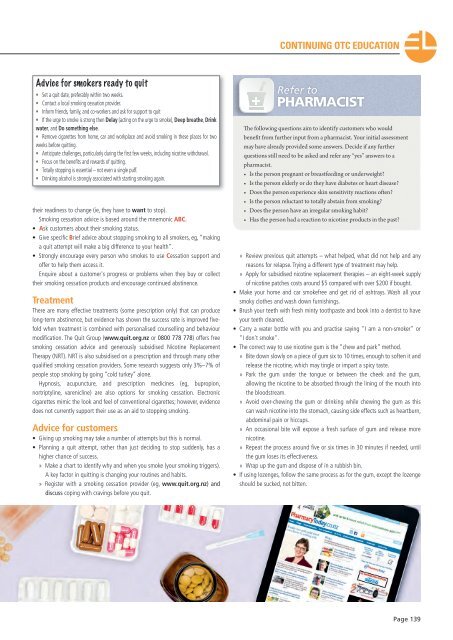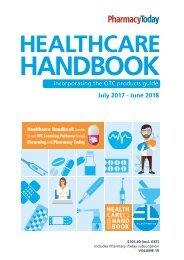2017 HCHB_digital
You also want an ePaper? Increase the reach of your titles
YUMPU automatically turns print PDFs into web optimized ePapers that Google loves.
CONTINUING OTC EDUCATION<br />
Advice for smokers ready to quit<br />
••<br />
Set a quit date, preferably within two weeks.<br />
••<br />
Contact a local smoking cessation provider.<br />
••<br />
Inform friends, family, and co-workers and ask for support to quit<br />
••<br />
If the urge to smoke is strong then Delay (acting on the urge to smoke), Deep breathe, Drink<br />
water, and Do something else.<br />
••<br />
Remove cigarettes from home, car and workplace and avoid smoking in these places for two<br />
weeks before quitting.<br />
••<br />
Anticipate challenges, particularly during the first few weeks, including nicotine withdrawal.<br />
••<br />
Focus on the benefits and rewards of quitting.<br />
••<br />
Totally stopping is essential – not even a single puff.<br />
••<br />
Drinking alcohol is strongly associated with starting smoking again.<br />
their readiness to change (ie, they have to want to stop).<br />
Smoking cessation advice is based around the mnemonic ABC.<br />
• Ask customers about their smoking status.<br />
• Give specific Brief advice about stopping smoking to all smokers, eg, “making<br />
a quit attempt will make a big difference to your health”.<br />
• Strongly encourage every person who smokes to use Cessation support and<br />
offer to help them access it.<br />
Enquire about a customer's progress or problems when they buy or collect<br />
their smoking cessation products and encourage continued abstinence.<br />
Treatment<br />
There are many effective treatments (some prescription only) that can produce<br />
long-term abstinence, but evidence has shown the success rate is improved fivefold<br />
when treatment is combined with personalised counselling and behaviour<br />
modification. The Quit Group (www.quit.org.nz or 0800 778 778) offers free<br />
smoking cessation advice and generously subsidised Nicotine Replacement<br />
Therapy (NRT). NRT is also subsidised on a prescription and through many other<br />
qualified smoking cessation providers. Some research suggests only 3%–7% of<br />
people stop smoking by going “cold turkey” alone.<br />
Hypnosis, acupuncture, and prescription medicines (eg, bupropion,<br />
nortriptyline, varenicline) are also options for smoking cessation. Electronic<br />
cigarettes mimic the look and feel of conventional cigarettes; however, evidence<br />
does not currently support their use as an aid to stopping smoking.<br />
Advice for customers<br />
• Giving up smoking may take a number of attempts but this is normal.<br />
• Planning a quit attempt, rather than just deciding to stop suddenly, has a<br />
higher chance of success.<br />
»»<br />
Make a chart to identify why and when you smoke (your smoking triggers).<br />
A key factor in quitting is changing your routines and habits.<br />
»»<br />
Register with a smoking cessation provider (eg, www.quit.org.nz) and<br />
discuss coping with cravings before you quit.<br />
Refer to<br />
PHARMACIST<br />
The following questions aim to identify customers who would<br />
benefit from further input from a pharmacist. Your initial assessment<br />
may have already provided some answers. Decide if any further<br />
questions still need to be asked and refer any “yes” answers to a<br />
pharmacist.<br />
• Is the person pregnant or breastfeeding or underweight?<br />
• Is the person elderly or do they have diabetes or heart disease?<br />
• Does the person experience skin sensitivity reactions often?<br />
• Is the person reluctant to totally abstain from smoking?<br />
• Does the person have an irregular smoking habit?<br />
• Has the person had a reaction to nicotine products in the past?<br />
» » Review previous quit attempts – what helped, what did not help and any<br />
reasons for relapse. Trying a different type of treatment may help.<br />
» » Apply for subsidised nicotine replacement therapies – an eight-week supply<br />
of nicotine patches costs around $5 compared with over $200 if bought.<br />
• Make your home and car smokefree and get rid of ashtrays. Wash all your<br />
smoky clothes and wash down furnishings.<br />
• Brush your teeth with fresh minty toothpaste and book into a dentist to have<br />
your teeth cleaned.<br />
• Carry a water bottle with you and practise saying "I am a non-smoker" or<br />
"I don't smoke".<br />
• The correct way to use nicotine gum is the “chew and park” method.<br />
» » Bite down slowly on a piece of gum six to 10 times, enough to soften it and<br />
release the nicotine, which may tingle or impart a spicy taste.<br />
» » Park the gum under the tongue or between the cheek and the gum,<br />
allowing the nicotine to be absorbed through the lining of the mouth into<br />
the bloodstream.<br />
» » Avoid over-chewing the gum or drinking while chewing the gum as this<br />
can wash nicotine into the stomach, causing side effects such as heartburn,<br />
abdominal pain or hiccups.<br />
» » An occasional bite will expose a fresh surface of gum and release more<br />
nicotine.<br />
» » Repeat the process around five or six times in 30 minutes if needed, until<br />
the gum loses its effectiveness.<br />
» » Wrap up the gum and dispose of in a rubbish bin.<br />
• If using lozenges, follow the same process as for the gum, except the lozenge<br />
should be sucked, not bitten.<br />
Page 139



